However, the difficulties of getting around in the chaos of post-war Japan irked Honda, so when he came across a job lot of generator engines he realised that here was a way of getting people mobile again at low cost.
A 12 by 18-foot shack in Hamamatsu became his first bike factory, fitting the generator motors into pushbikes. Before long he'd used up all 500 generator motors and started manufacturing his own engine, known as the 'chimney', either because of the elongated cylinder head or the smoky exhaust or perhaps both The chimney made all of half a horsepower from its 50 cc engine but it was a major success and became the Honda A-type.
Less than two years after he'd set up in Hamamatsu, Soichiro Honda founded the Honda Motor Company in September 1948. By then, the А-type had been developed into the 90 cc В-type engine, which Mr Honda decided deserved its own chassis not a bicycle frame. Honda was about to become Japan's first post-war manufacturer of complete motorcycles. In August 1949 the first prototype was ready. With an output of three horsepower, the 98 cc D-type was still a simple two-stroke but it had a two-speed transmission and most importantly a pressed steel frame with telescopic forks and hard tail rear end. The frame was almost triangular in profile with the top rail going in a straight line from the massively braced steering head to the rear axle. Legend has it that after the D-type's first tests the entire workforce went for a drink to celebrate and try and think of a name for the bike. One man broke one of those silences you get when people are thinking, exclaiming «This is like a dream! That's it!» shouted Honda, and so the Honda Dream was christened.

Honda C70 and C90 OHV-engined models
«This is like a dream! That's it shouted Honda»
Mr Honda was a brilliant, Intuitive engineer and designer but he did not bother himself with the marketing side of his business. With hindsight, It is possible to see that employing Takeo Fujisawa who would both sort out the home market and plan the eventual expansion into overseas markets was a masterstroke. He arrived in October 1949 and in 1950 was made Sales Director. Another vital new name was Kiyoshi Kawashima, who along with Honda himself, designed the company's first four-stroke after Kawashima had told them that the four-stroke opposition to Honda's two-strokes sounded nicer and therefore sold better. The result of that statement was the overhead-valve 148 cc E-type which first ran in July 1951 just two months after the first drawings were made. Kawashima was made a director of the Honda Company at 34 years old.
The E-type was a massive success, over 32,000 were made in 1953 alone, a feat of mass-production that was astounding by the standards of the day given the relative complexity of the machine. But Honda's lifelong pursuit of technical innovation sometimes distracted him from commercial reality, Fujisawa pointed out that they were in danger of ignoring their core business, the motorised bicycles that still formed Japan's main means of transport. In May 1952 the F-type Cub appeared, another two-stroke despite the top men's reservations. You could buy a complete machine or just the motor to attach to your own bicycle. The result was certainly distinctive, a white fuel tank with a circular profile went just below and behind the saddle on the left of the bike, and the motor with its horizontal cylinder and bright red cover just below the rear axle on the same side of the bike. This was the machine that turned Honda into the biggest bike maker in Japan with 70% of the market for bolt-on bicycle motors, the F-type was also the first Honda to be exported. Next came the machine that would turn Honda into the biggest motorcycle manufacturer in the world.
The C100 Super Cub was a typically audacious piece of Honda engineering and marketing. For the first time, but not the last, Honda invented a completely new type of motorcycle, although the term 'scooterette' was coined to describe the new bike which had many of the characteristics of a scooter but the large wheels, and therefore stability, of a motorcycle. The first one was sold in August 1958, fifteen years later over nine-million of them were on the roads of the world. If ever a machine can be said to have brought mobility to the masses it is the Super Cub. If you add in the electric starter that was added for the C102 model of 1961, the design of the Super Cub has remained substantially unchanged ever since, testament to how right Honda got it first time. The Super Cub made Honda the world's biggest manufacturer after just two years of production.
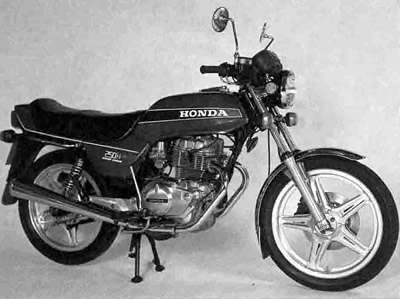
The CB250N Super Dream became a favorite with UK learner riders of the late seventies and early eighties
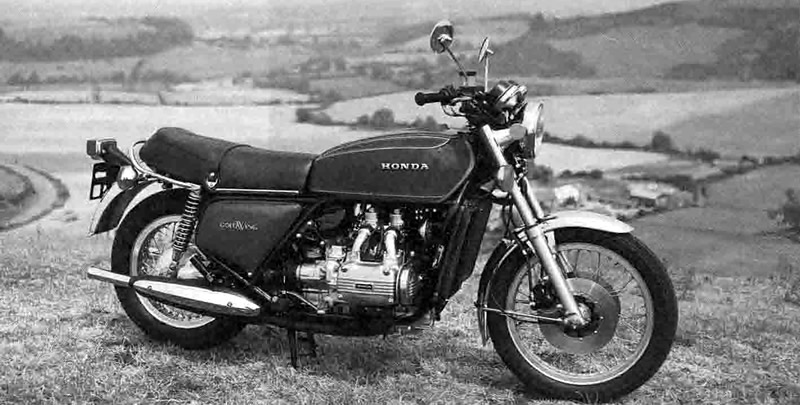
The GL1000 introduced in 1975, was the first in Honda's line of GoldWings
Honda's export drive started in earnest in 1957 when Britain and Holland got their first bikes, America got just two bikes the next year. By 1962 Honda had half the American market with 65,000 sales. But Soichiro Honda had already travelled abroad to Europe and the USA, making a special point, of going to the Isle of Man TT, then the most important race in the GP calendar. He realised that no matter how advanced his products were, only racing success would convince overseas markets tor whom 'Made in Japan' still meant cheap and nasty It took five years from Soichiro Honda's first visit to the Island before his bikes were ready for the TT. In 1959 the factory entered five riders in the 125 class. They did not have a massive impact on the event being benevolently regarded as a curiosity, but sixth, seventh and eighth were good enough for the team prize. The bikes were off the pace but they were well engineered and very reliable.
The TT was the only time the West saw the Hondas in '59, but they came back for more the following year with the first of a generation of bikes which shaped the future of motorcycling - the double-overhead-cam four-cylinder 250. It was fast and reliable - it revved to 14,000 rpm - but didn't handle anywhere near as well as the opposition. However, Honda had now signed up nonJapanese riders to lead their challenge. The first win didn't come until 1962 (Aussie Tom Phillis in the Spanish 125 GP) and was followed up with a world-shaking performance at the TT. Twenty-one year old Mike Hailwood won both 125 and 250 cc TTs and Hondas filled the top five positions in both races. Soichiro Honda's master plan was starting to come to fruition. Hailwood and Honda won the 1961 250 cc World Championship. Next year Honda won three titles. The other Japanese factories fought back and inspired Honda to produce some of the most fascinating racers ever seen: the awesome six-cylinder 250, the five-cylinder 125, and the 500 four with which the immortal Hailwood battled Agostini and the MV Agusta. When Honda pulled out of racing in '67 they had won sixteen rider's titles, eighteen manufacturer's titles, and 137 GPs, including 18 TTs, and introduced the concept of the modern works team to motorcycle racing. Sales success followed racing victory as Soichiro Honda had predicted, but only because the products advanced as rapidly as the racing machinery. The Hondas that came to Britain in the early '60s were incredibly sophisticated. They had overhead cams where the British bikes had pushrods, they had electric starters when the Brits relied on the kickstart, they had 12V electrics when even the biggest British bike used a 6V system. There seemed no end to the technical wizardry. It wasn't that the technology itself was so amazing but just like that first E-type, it was the fact that Honda could mass-produce it more reliably than the lower-tech competition that was so astonishing.

Carl Fogarty in action at the Suzuka 8 Hour on the RC45
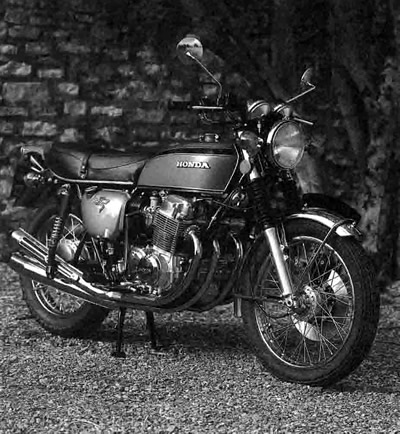
An early CB750 Four
When in 1968 the first four-cylinder CB750 road bike arrived the world of motorcycling changed for ever, they even had to invent a new word for it. 'Superbike'. Honda raced again with the CB750 at Daytona and won the
World Endurance title with a prototype DOHC version that became the CB900 roadster. There was the six-cylinder CBX. the CX500T -the world's first turbocharged production bike, they invented the full-dress tourer with the GoldWing, and came back to GPs with the revolutionary oval-pistoned NR500 four-stroke, a much-misunderstood bike that was more a rolling experimental laboratory than a racer. Just to show their versatility Honda also came up with the weird CX500 shaft-drive V-twin. a rugged workhorse that powered a new industry, the courier companies that oiled the wheels of commerce in London and other big cities.
It was true, though, that Mr Honda was not keen on two-strokes - early motocross engines had to be explained away to him as lawnmower motors! However, in 1982 Honda raced the NS500. an agile three-cylinder lightweight against the big four-cylinder opposition in 500 GPs. The bike won in its first year and in '83 took the world title for Freddie Spencer. In four-stroke racing the V4 layout took over from the straight four, dominating TT, F1 and Endurance championships with the RVF750. the nearest thing ever built to a Formula 1 car on wheels. And when Superbike arrived Honda were ready with the RC30. On the roads the VFR V4 became an instant classic while the CBR600 invented another new class of bike on its way to becoming a best-seller. The V4 road bikes had problems to start with but the VFR750 sold world-wide over its lifetime while the VFR400 became a massive commercial success and cult bike in Japan. The original RC30 won the first two World Superbike Championships is 1988 and '89, but Honda had to wait until 1997 to win it again with the RC45, the last of the V4 roadsters. In Grands Prix, the NSR500 V4 two-stroke superseded the NS triple and became the benchmark racing machine of the '90s. Mick Doohan secured his place in history by winning five World Championships In consecutive years on it.
n yet another example of Honda inventing a new class of motorcycle, they came up with the astounding CBR900RR FireBlade, a bike with the punch of a 1000 cc motor in a package the size and weight of a 750. It became a cult bike as well as a best seller, and with judicious redesigns continues to give much more recent designs a run for their money.
When it became apparent that the high-tech V4 motor of the RC45 was too expensive to produce, Honda looked to a V-twin engine to power its flagship for the first time. Typically, the VTR1000 FireStorm was a much more rideable machine than its opposition and once accepted by the market formed the basis of the next generation of Superbike racer, the VTR-SP-1.
One of Mr Honda's mottos was that technology would solve the customers' problems, and no company has embraced cutting-edge technology more firmly than Honda. In fact Honda often developed new technology, especially in the fields of materials science and metallurgy. The embodiment of that was the NR750, a bike that was misunderstood nearly as much as the original NR500 racer. This limited-edition technological tour-de-force embodied many of Soichiro Honda's ideals. It used the latest techniques and materials in every component, from the oval piston. 32-valve V4 motor to the titanium coating on the windscreen, it was -as Mr Honda would have wanted - the best it could possibly be. A fitting memorial to Ilie man who has shaped the motorcycle industry and motorcyles as we know them today.
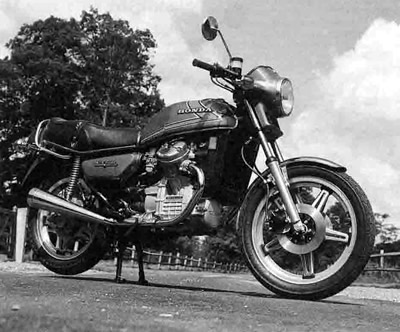
The CX500 - Honda's first V-Twin and a favorite choice of dispatch riders

The VFR400R was a cult bike in Japan and a popular grey import in the UK
Honda Transalp & Africa Twin
When Honda announce that they have invented a new type of motorcycle, the world tends to think of the initials CB. VFR and NR. Imagine, then, the confusion the world's press felt on being confronted with the Transalp and being told that it was a 'Rally Tourer'. This was 1987 and the Paris-Dakar rally had already spawned knobbiytyred race-replicas like the Yamaha Тёпёгё, the bike that sold over 10,000 units in six months on Continental Europe.
But Honda, being Honda, didn't serve up a replica of their mighty NXR750 works desert racer, in fact the only thing the NXR and the Transalp XL600V had in common was the V-twin configuration of their engines. Just like the first VFR750, the first Transalp was decidedly understated, plain even. This was, of course, an attempt to get away from the already burgeoning obsession with sportsters n several important markets by re-inventing the all-round motorcycle in a non-boring fashion.
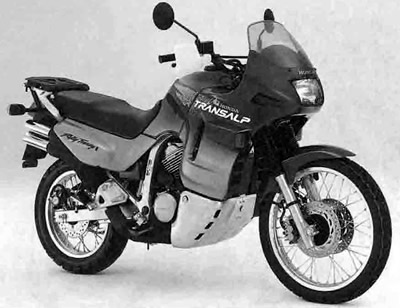
The 1998 XL600V-W Transalp
To this end, they bored and stroked the VT500's motor and fitted it in a steel duplex-cradle frame with good quality suspension at both ends. The forks had an off-road friendly eight inches of movement and the rear shock over seven, but the rider got the sort of comprehensive instrumentation you only saw on a top-end road bike plus the sort of powerful brakes that are more of a hindrance than help on dirt surfaces. The Transalp could be taken off road but no-one in their right mind would buy one for trail riding, however the plush suspension and comfortable power delivery worked perfectly on the sort of pot-holed, gravel strewn minor roads that characterise much of the rural parts of countries like France and Italy. Not that the Transalp was a slouch on good tarmac. Honda were confident enough to launch it alongside the new CBRs at the Suzuka Circuit where it was surefooted enough round the twisty bits to hang on to the fours without any dramas.
Contemporary tests show that the bike impressed and confused in equal measure but the Transalp while not fashionable did do what it was meant to and consequently sold steadily over the years. It's a measure of just how right it was that it has changed so little through its life.
For the first ten years of its life the XL600V Transalp didn't alter noticeably apart from the rear brake graduating from a drum to a disc in 1991. In 1997 production moved from Japan to Honda's Italian plant and you can recognise that year's V-V model by the twin front Brembo calipers replacing the Japanese Nissin units. Thal was just the prequel to the Transalp's only major modifications. The year 2000 XL650V-Y got a 650 cc motor in a totally new-look motor-cycle. The suspension and wheels stayed the same but bodywork, instrumentation, electrical systems and lights were all changed to bring the styling up to date. European concerns were also addressed with the fitting of Honda's HISS immobiliser and PAIR emission control system.
We had to wait until 1990 to find out why Honda had so underplayed the Paris-Dakar heritage of the Transalp, for that was when the Africa Twin was unleashed. This was a real race replica with stratospheric seat height, suspension with what seemed like endless travel, a giant fuel tank, twin trip meters and an aluminium chassis. Here was something that looked and rode like the bikes that thrashed across the Sahara every January. The motor was a bored and stroked version of the Transalp's V-twin. Note that there was an earlier version of the Africa Twin, the 1989 XRV650, although this was not imported into the UK.
Everyone agreed, here was a fantastic motorcycle, the suspension and brakes came in for special praise, one that you could ride all day two-up in comfort on anything from autobahns to dirt tracks In typical Honda fashion the build quality was superb but there was just one problem: price. In markets like the UK the Africa Twin cost more than a CBR600 and it didn't matter how good the bike was, the punters wouldn't pay that much for a twin. It's their loss, the Africa Twin is a great motorcycle and has become a cult bike in countries like France and Germany where the Paris-Dakar Rally is a highlight of the sporting calendar.

The 1998 XRV750-W Africa Twin
